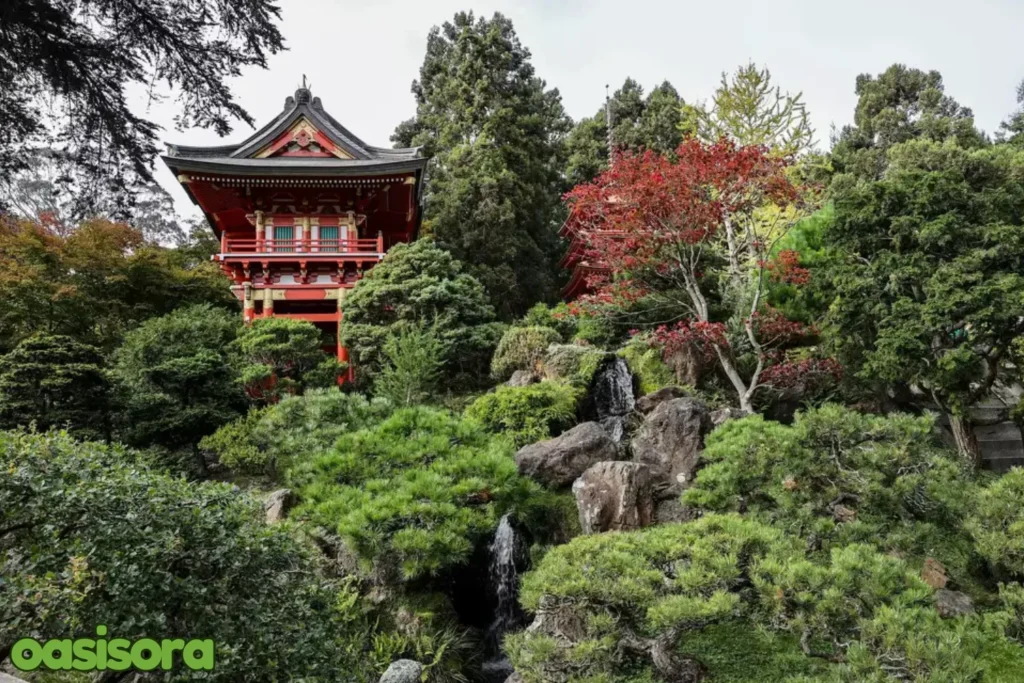
A view of autumn foliage at the Japanese Tea Garden in Golden Gate Park of San Francisco, California, on October 20, 2022. Attendance at the garden soars during spring’s cherry blossom season and again in the fall, when the leaves begin to change color.
Tea garden is a peaceful, simple place to relax with the natural world. Art, traditions, and nature all work well together there. Each part of these gardens has its importance and meaning.
People go there all the time just to chill and take tea. This Guide to Japanese Tea Garden will help you understand its history, design, and peaceful atmosphere.
What is a Japanese Tea Garden?
Japanese tea gardens are also known as roku. Parks with little bridges, ponds, trees, and stone paths are a custom in Japan. One of the main goals is to hold tea events in a place that is calm and peaceful so that people can rest and enjoy their time.
You can do more than just drink tea on these grounds. You can also meditate and rest here.
The History of Japanese Tea Gardens
A long time ago, tea gardens started to grow all over the country. People created them so they might have tea in natural and serene environments. Initially, they were simply quiet areas for tea ceremonies.
These gardens were meant to allow individuals to relax and concentrate and bring them closer to the natural surroundings. However, the past of some tea gardens was not simple, particularly those located in the United States. This guide to Japanese tea garden helps us to know about its history and origin.
Origins of Japanese Tea Gardens in Japan
In the 12th century, Buddhist monks brought tea from China to Japan and made the foundation of these Tea Gardens. After some time, tea became famous in Japan and the Japanese started to make special grounds for the tea ceremony.
Moreover, these gardens were motivated by Zen Buddhism which emphasized simplicity.
Sen no Rikyū and the Evolution of Tea Gardens
In Japan, there was a renowned tea master Sen no Rikyū. He changed the look of tea gardens in the sixteenth century and believed everything that we placed in the garden should be simple and natural.
He urged individuals to create a natural space where guests might leave behind their concerns and concentrate on the current moment, therefore discouraging over-decorating and introducing “wabi-sabi”.
His idea gained great popularity and people structured their gardens exactly like that.
Japanese Tea Gardens in the United States
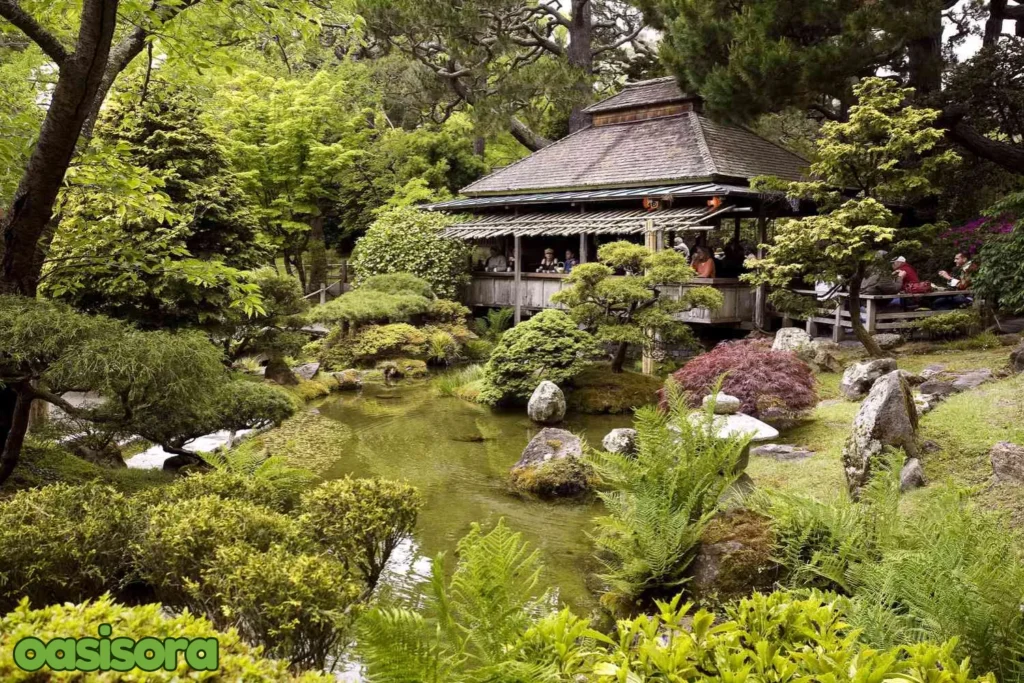
Golden Gate Park’s Japanese Tea Garden
Golden Gate Park’s Japanese Tea Garden, as it appeared in 1904. The tea garden was built as part of a Japanese Village exhibit for the California Midwinter International Exposition of 1894.
There is a famous garden in San Francisco that has a complex history. This garden was named “Japanese Village,”. In 1894, it was one of the most popular exhibitions in California. Although the displays were supposed to highlight many civilizations from around the globe, most of them focused on racist beliefs.
An Australian named George Turner Marsh devised the idea for the Japanese Village. He lived in Japan, where he bought and collected furniture. Marsh bought plants and buildings for the fair and paid Japanese builders to build the space. This garden consisted of:
- Shuro-no-mon gate
- well-maintained gardens
- Waterfalls
- Ponds
- Tea rooms
- Ni-Kai-Yashiki (a two-story nobleman’s house)
- An artist’s studio
- A restaurant
- The Drum Bridge
The Role of Makoto Hagiwara
Our precise guide to Japanese Tea garden highlights the part of Makoto in constructing Zen landscapes. Most of these buildings were burned when the fair was over.
On the other hand, Marsh hired Makoto Hagiwara, a Japanese landscape planner, to take care of the gardens. Hagiwara suggested that he make a deal with John McLaren, who is in charge of Golden Gate Park so that the show could stay there.
He and his family lived in the garden for many years, until he died in 1925. He added a lot to the grounds during that time, like:
- Cherry trees
- Koi fish
- Native plants.
World War II and the Forced Removal of the Hagiwara Family
The Hagiwara family was sent to a jail camp with 120,000 other Japanese Americans in 1942, a long time after Makoto’s death. They removed many traditional Japanese elements from the garden, such as
- The Shinto shrine and the home of the Hagiwara family.
- Changed name to “The Oriental Tea Garden.”
- After the war, the city rented the grounds to Alan Agnew.
The Renaming and Restoration of the Japanese Tea Garden
When the US and Japan made a peace agreement in the early 1950s, the garden was again renamed and also restored a few important components:
- Three Japanese partners took over the lease in 1958 and worked for decades to build the garden and tea house.
- The SF Botanical Garden Society and the San Francisco Recreation & Parks Department recently made the garden a part of the Gardens of Golden Gate Park.
- The Japanese Tea Garden, the San Francisco Botanical Garden, and the Conservatory of Flowers are all run by this group.
Japan Tea Gardens continued to develop over time. In churches, palaces, and even public places, they were very important. When Japan started sharing its culture with the world, these gardens were introduced in different countries.
Now, you can find them in many places outside Japan like the United States and Europe.
The Essential Elements of a Japanese Tea Garden
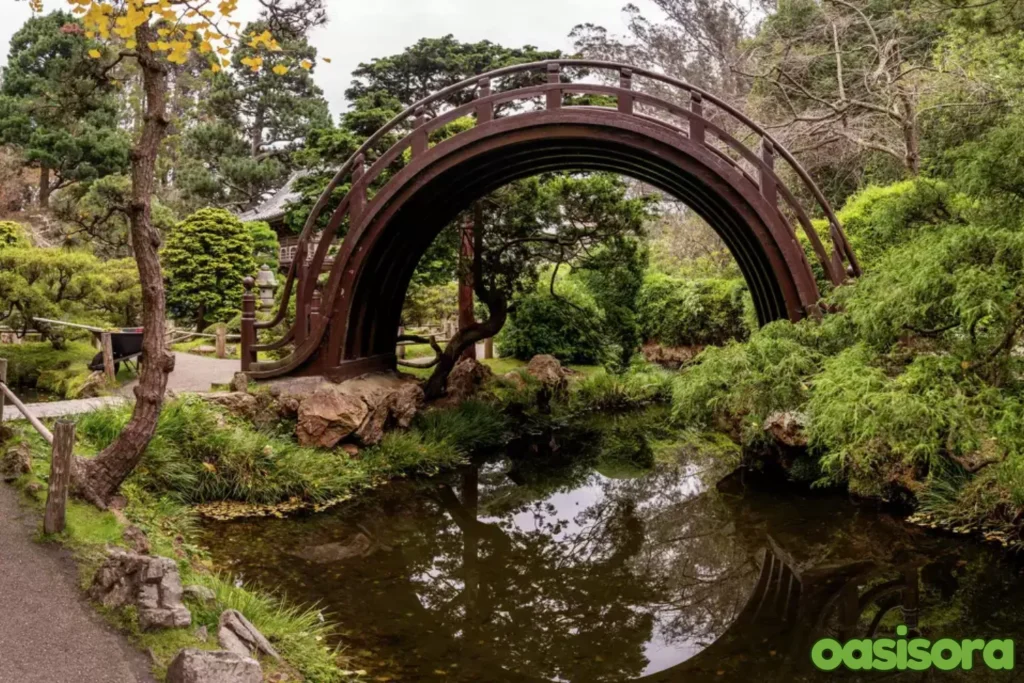
Drum bridge at the Japanese Tea Garden in San Francisco’s Golden Gate Park
The drum bridge at the Japanese Tea Garden in San Francisco’s Golden Gate Park is beloved by adult visitors for its pleasing appearance and by children visitors for the challenge of walking up and down its steep span.
Many elements make the tea garden a wonderful space. They add balance and beauty in the garden. Guide to Japanese tea garden helps us to find the most important features found in such areas.
The Path (Roji): Symbolic Journey
People can walk through the park on the Roji path, which is made of stones. It is not just for walking, but also represents a spiritual journey. When people walk on it, they leave behind the outside world and enter a place of mindfulness.
The stones are placed on the path randomly. This makes visitors walk slowly and carefully, which helps them to stay focused on the moment. While some roads lead to the tea house, where the ceremony takes place, others lead to peaceful spots where people can think.
Lanterns: Lighting the Way
In such Tea Gardens, you can commonly see stone lanterns. These lanterns are made from rock and vary in size and form. Mostly at night, people placed them next to water or along pathways to provide a gentle and serene glow.
People who were going to an evening tea party used lanterns to light the way. In modern times, they’re mostly used as pretty garden decorations. People who come to see the lanterns feel calm and linked to nature because their light stands for wisdom and direction.
Gates: Transition from Outer World to Inner Peace
A gate is an important part of a Tea Garden. It marks the entry and keeps the garden peaceful from the outer world. People leave their concerns behind when they pass the gate into a serene space. There are bamboo or wood gates available, and some have traditional Japanese style.
Well or Water Basin (Tsukubai): Cleansing Ritual
A water basin is also called Tsukubai. A small bowl made of stone that is full of water. People wash their hands and mouths there before going into the tea house.
This small deed is a gesture of cleaning that enables people to prepare for the tea ceremony with a fresh mind and soul. Usually, people arrange the bowl of water next to a bamboo spoon they use to acquire water for personal washing.Furthermore, the park’s water helps people feel peace and relaxation, enhancing the tranquility of a Japanese water feature.
Layout and Structure of a Japanese Tea Garden
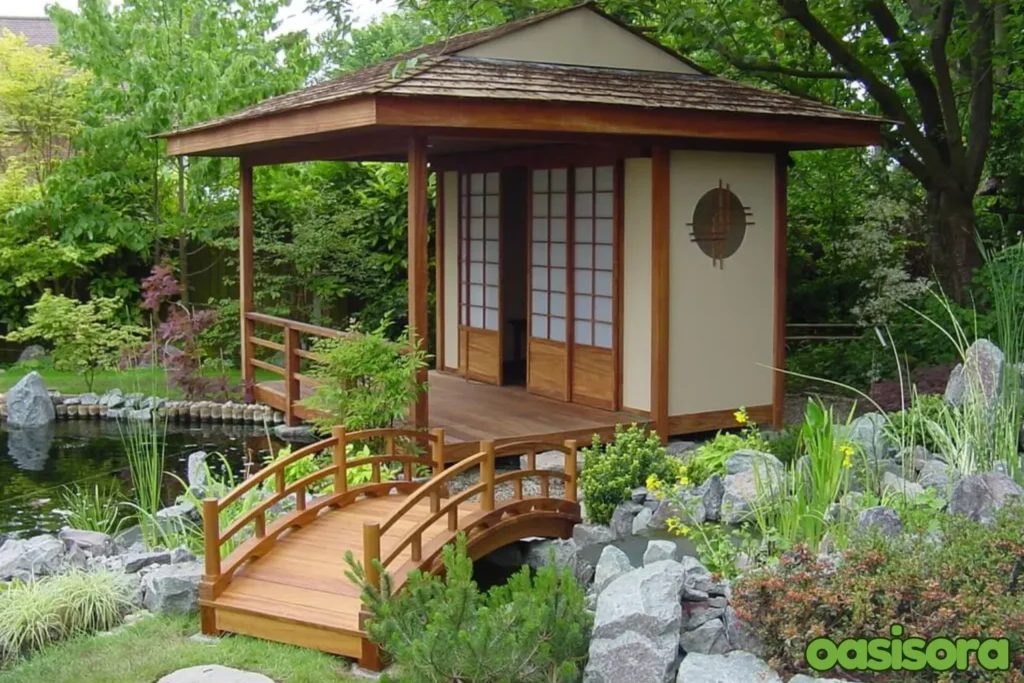
Structure of Japanese Tea Garden
A Zen tea garden provides natural and serene surroundings. It consists of many areas meant for different purposes. This guide to Japanese tea gardens with simple and traditional architecture helps people to find serenity and be close to nature.
Outer Garden (Soto Roji)
The outer garden is also called Soto Roji. It is the entrance area that prepares visitors for the quiet and peaceful space inside. This part of the garden has:
- Stone paths that guide visitors forward.
- Green trees and plants will naturally look great.
- A simple gate to mark the entrance.
Inner Garden (Uchi Roji)
The inner garden is known as Uchi Roji. It is a more private and peaceful space. It is closer to the tea house, where the tea ceremony happens. This part of the garden has:
- A water basin (Tsukubai) for guests to wash their hands before entering
- Soft lighting from stone lanterns
- A simple and quiet design to help visitors feel relaxed
The Tea House (Chashitsu): Heart of the Garden
The teahouse is called Chashitsu. This element of the Tea Garden is the most crucial for the tea ritual. You can also call it the heart of the garden.
People come and sit in the tea house and enjoy the traditional tea service with a serene, polite, and quiet atmosphere; The tea house is a small and simple wooden building with:
- A low door to tell people to be humble
- There are tatami mats (straw mats) on the floor.
- Sliding doors that open to the garden
Plants and Natural Features of a Japanese Tea Garden
Japanese Tea houses are beautiful, quiet places with lots of plants and other natural things. The garden is calm, balanced, and easy to use because each plant and feature was selected with care.
Evergreen Shrubs and Moss: Tranquility and Simplicity
Such Tea Gardens need plants that stay green all year and moss with a natural and soft look. In Japanese society, beauty and simplicity are very important. These plants demonstrate these qualities.
- A small tree or bush that doesn’t lose its leaves is called an evergreen plant. They make the garden look calm and new all year long.
- Moss covers rocks, grounds, and roads. The garden feels soft and quiet, like a calm forest because of it.
Bamboo and Other Traditional Plants
Our guide to Japanese Tea Garden suggests that Bamboo is a commonly utilized plant in Zen Tea places. Many gardeners love to plant because this plant grows tall and strong easily, therefore it is a good source of power and tranquility.
It is also relaxing for many people to hear bamboo leaves blowing in the wind.
Other plants often found in the garden include:
- Cherry trees bloom in pink in the spring to highlight the beauty of the outdoors.
- With the red and orange maple tree leaves, fall gives the garden color.
- Irises and camellias improve the appearance of the garden and offer gentle colors.
Water Elements: Ponds, Streams, and Stones
A Japanese Garden for tea doesn’t work without water. The place feels alive and calm because of it. People feel good when they think about life and how beautiful nature is.
- The ponds with koi fish make the spot feel calm and lively.
- The sound of streams moving slowly is soothing and calm.
- Stones are placed near the water to balance the garden and make it look natural.
The Role of Tea Ceremonies in Japanese Tea Gardens
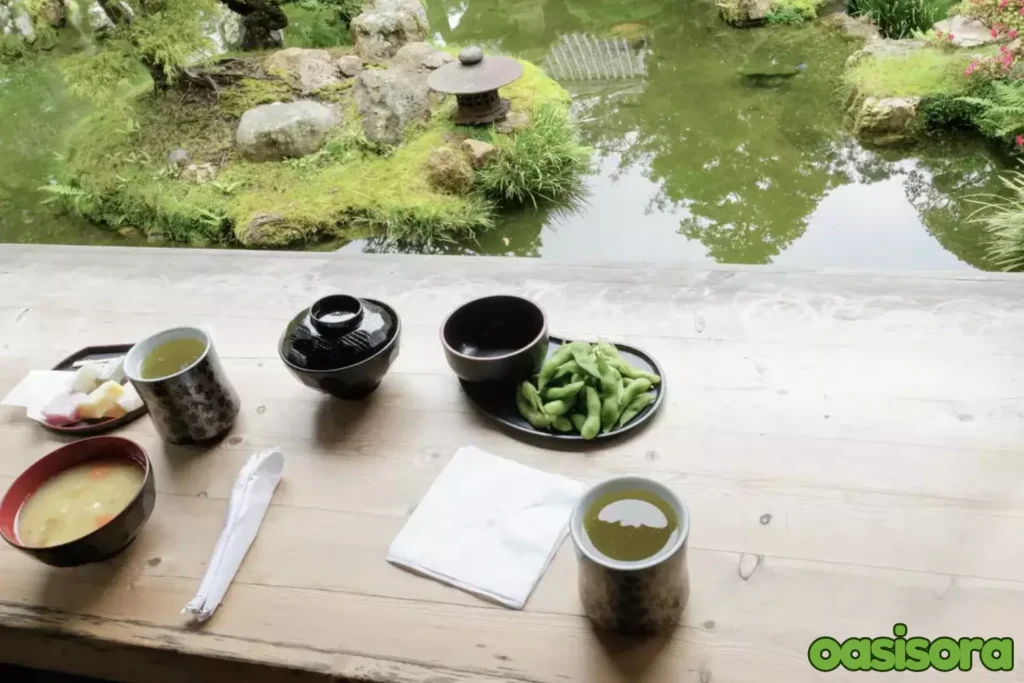
Variety of Japanese tea and snacks in Japanese Tea Garden
The Tea House at the Japanese Tea Garden in San Francisco’s Golden Gate Park serves a variety of Japanese tea and snacks and a tranquil view of the gardens.
The role of tea ceremonies in Japan is the most important part of its culture. It offers a peaceful and quiet approach to prepare and have tea. However, the ceremony is an old practice, but it brings a lot of peace and awareness among people.
There is a Japanese Garden that is made to go with the tea service. Before going into the tea house, the garden helps people feel calm and focused on each element.
The stone walkways, lanterns, and water basins will make the experience simple and quiet. At the tea ceremony, people sit in the tea house and enjoy the slow, careful process of making tea. Everyone likes the tea that the host makes with style and care.
Symbolism and Meaning in Japanese Tea Gardens
These gardens are not only a lovely location. Every feature of the garden has particular significance.
- It is a peace symbol. One should sense peace and relaxation in the garden. The gentle sounds of wind and water let guests forget their worries.
- Simplicity is the most important for these places. These gardens are not too crowded with plants or decorations. This reminds others to appreciate small pleasures in daily life.
- Mindfulness is the key symbol. People can slow down and enjoy the present moment by walking through it.
Visiting a Japanese Tea Garden: What to Expect
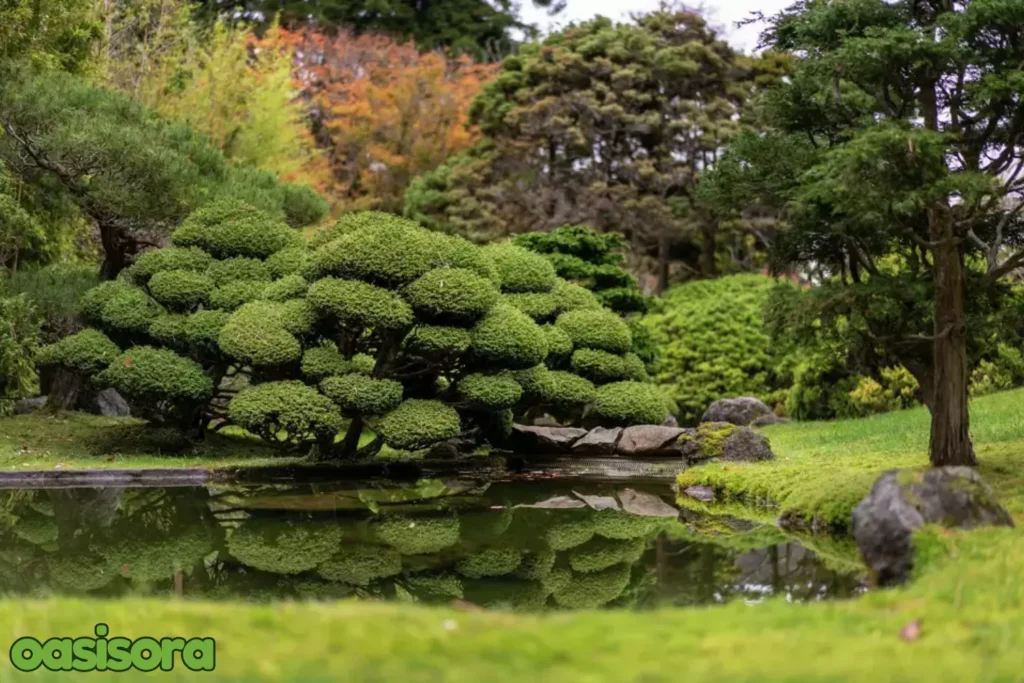
Fixture of Golden Gate Park in San Francisco
The Japanese Tea Garden, a beloved fixture of Golden Gate Park in San Francisco, Calif., is known for its serene and varied beauty, but its history includes upheaval, internment and racism.
Are you ready to go there?. Our guide to Japanese tea garden suggests when would be the ideal visit for this location.
Fall, when the leaves are changing, is the ideal season to visit these places; spring, when the cherry trees are in blossom, is another option. However, you can enjoy it in any season of the year by:
- Take a walk on the stone paths and enjoy the peace and beauty.
- Look out for the lanterns and gates that are used to mark off different places.
- Listen to the sound of water running and watch koi fish in the pond.
- Learn how to make Japanese tea by going to the tea house.
Final Thoughts:
Creating Your Japanese Tea Garden: Design Tips
A Tea Garden in Japan is about designing a place where you feel at ease and connected to the surroundings, not only about tea or plants.
Such beautiful places can also be made in your own home or backyard. It doesn’t need to be big; a small space with few essentials is sufficient. Here are some easy tips:
- Choose a spot with less noise and more light from the outside.
- Use easy plants like bamboo, moss, and shrubs that stay green all year.
- A small road to walk on can be made by putting flat stones on the ground.
- A small pond or water basin can be beautiful and peaceful.
- Don’t add too much; keep it simple and clean.
Experience the peace and beauty of nature with this Guide to Japanese Tea Garden.
.
